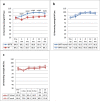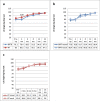Autograft type affects muscle strength and hop performance after ACL reconstruction. A randomised controlled trial comparing patellar tendon and hamstring tendon autografts with standard or accelerated rehabilitation
- PMID: 33128587
- PMCID: PMC8384829
- DOI: 10.1007/s00167-020-06334-5
Autograft type affects muscle strength and hop performance after ACL reconstruction. A randomised controlled trial comparing patellar tendon and hamstring tendon autografts with standard or accelerated rehabilitation
Abstract
Purpose: To evaluate and compare changes in quadriceps and hamstring strength and single-leg-hop (SLH) test performance over the first 24 postoperative months in patients who underwent anterior cruciate ligament reconstruction (ACLR) with bone-patellar tendon-bone (BPTB) or hamstring tendon (HT) autografts and followed either a standard or an accelerated rehabilitation protocol.
Methods: A total of 160 patients undergoing ACLR were randomised in four groups depending on the graft that was used and the rehabilitation protocol (40 BPTB/standard rehab, 40 BPTB/accelerated rehab, 40 HT/standard rehab, 40 HT/accelerated rehab). Isokinetic concentric quadriceps and hamstring strength at 90°/s and the SLH test performance were assessed preoperatively and 4,6,8,12 and 24 months postoperatively. The results were reported as the limb symmetry index (LSI) at the same time point. Linear mixed models were used to compare the groups at the different time points.
Results: An average quadriceps strength LSI of 78.4% was found preoperatively. After ACLR, the LSI first decreased at 4 months and then increased from 6 to 24 months, reaching an overall value of 92.7% at the latest follow-up. The BPTB group showed a significantly decreased LSI at 4, 6, 8 and 12 months compared with the HT group. No significant differences between the graft groups were found at 24 months. An average hamstring strength LSI of 84.6% was found preoperatively. After ACLR, the LSI increased from 4 to 24 months in the BTPB group. In the HT group, the LSI first decreased at 4 months and then increased from 6 to 24 months. An LSI of 97.1% and 89.1% was found at the latest follow-up for the BPTB and the HT group, respectively. The HT group showed a significantly decreased LSI at all follow-ups compared with the BPTB group. An average SLH test LSI of 81% was found preoperatively. After ACLR, the LSI increased from 4 to 24 months, reaching 97.6% overall at the latest follow-up. The BPTB group showed a significantly decreased LSI only at 4 months postoperatively compared with the HT group. No significant differences in any of the three tests were found between the standard and accelerated rehabilitation groups for either of the graft groups at any time point.
Conclusion: Muscle strength and SLH test performance recovered progressively after ACLR overall, but they did not all fully recover, as the injured leg performed on average less than 100% compared with the uninjured leg even 24 months postoperatively. After ACLR, inferior quadriceps strength and a poorer SLH test performance were found at 4, 6, 8 and 12 months and at 4 months, respectively, for the BTPB group compared with the HT group. Persistent, inferior hamstring strength was found at all postoperative follow-ups in the HT group. Rehabilitation, standard or accelerated, had no significant impact on the recovery of muscle strength and SLH test performance after ACLR in any of the graft groups.
Level of evidence: Level I.
Keywords: ACL; Anterior cruciate ligament; Graft; Hamstring; Hamstring strength; Hop test; Limb symmetry index; Muscle strength; Patellar tendon; Quadriceps strength.
© 2020. The Author(s).
Conflict of interest statement
Each author declares that no possible conflict of interest (financial or not financial) exists in connection with this study.
Figures




References
-
- Ageberg E, Roos HP, Silbernagel KG, Thomeé R, Roos EM. Knee extension and flexion muscle power after anterior cruciate ligament reconstruction with patellar tendon graft or hamstring tendons graft: a cross-sectional comparison 3 years post surgery. Knee Surg Sports Traumatol Arthrosc. 2009;17(2):162–169. doi: 10.1007/s00167-008-0645-4. - DOI - PubMed
-
- Aglietti P, Giron F, Buzzi R, Biddau F, Sasso F. Anterior cruciate ligament reconstruction: bone-patellar tendon-bone compared with double semitendinosus and gracilis tendon grafts. A prospective, randomized clinical trial. J Bone Joint Surg Am. 2004;86(10):2143–2155. doi: 10.2106/00004623-200410000-00004. - DOI - PubMed
-
- Ahlbäck S. Osteoarthrosis of the knee. A radiographic investigation. Acta Radiol Diagn (Stockh) 1968;277:7–72. - PubMed
Publication types
MeSH terms
LinkOut - more resources
Full Text Sources
Medical
Research Materials

